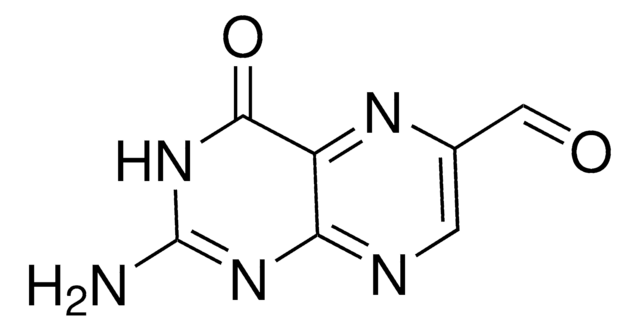SMB01333
Acetyl-6-formylpterin
≥95% (HPLC)
Synonyme(s) :
2-Acetamido-4-oxopteridine-6-carboxaldehyde, 2-Acetamido-6-formylpteridin-4(3H)-one, 2-Acetylamino-4-hydroxy-6-formylpteridine, 2-Acetamido-6-formylpteridin-4-one, N-(6-formyl-4-hydroxy-2-pteridinyl)acetamide, N-(6-formyl-4-oxo-1H-pteridin-2-yl)acetamide
About This Item
Produits recommandés
Niveau de qualité
Pureté
≥95% (HPLC)
Forme
powder
Température de stockage
−20°C
Chaîne SMILES
CC(=O)NC1=NC2=NC=C(N=C2C(=O)N1)C=O
InChI
1S/C9H7N5O3/c1-4(16)11-9-13-7-6(8(17)14-9)12-5(3-15)2-10-7/h2-3H,1H3,(H2,10,11,13,14,16,17)
Clé InChI
DDBCPKAHJKOGKK-UHFFFAOYSA-N
Vous recherchez des produits similaires ? Visite Guide de comparaison des produits
Description générale
Moreover, acetyl-6-formylpterin serves as a precursor in the synthesis of 2′-hydroxy-7,8-dihydrofolate, a metabolite associated with para-aminosalicylic acid (PAS) in M. tuberculosis. This compound′s versatility and involvement in various biological processes make it an intriguing molecule for metabolomics and biochemical research.
Application
- to study the potential reversal of iver fibrosis
- in metabolomics research
Actions biochimiques/physiologiques
Caractéristiques et avantages
- Can be used in Metabolomics and Biochemical research
- High-quality compound suitable for multiple research applications
Autres remarques
Code de la classe de stockage
11 - Combustible Solids
Classe de danger pour l'eau (WGK)
WGK 3
Point d'éclair (°F)
Not applicable
Point d'éclair (°C)
Not applicable
Choose from one of the most recent versions:
Certificats d'analyse (COA)
Sorry, we don't have COAs for this product available online at this time.
If you need assistance, please contact Service Clients
Déjà en possession de ce produit ?
Retrouvez la documentation relative aux produits que vous avez récemment achetés dans la Bibliothèque de documents.
Notre équipe de scientifiques dispose d'une expérience dans tous les secteurs de la recherche, notamment en sciences de la vie, science des matériaux, synthèse chimique, chromatographie, analyse et dans de nombreux autres domaines..
Contacter notre Service technique






